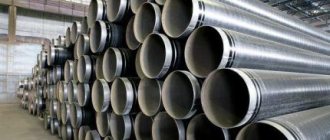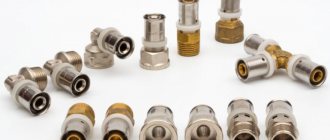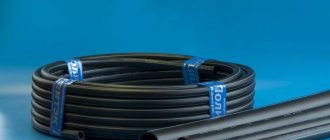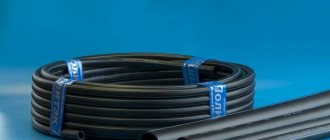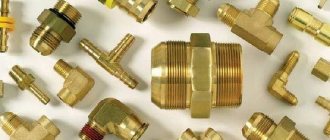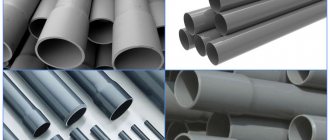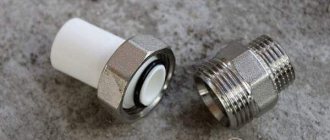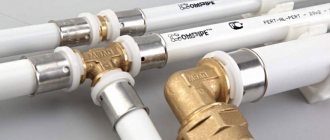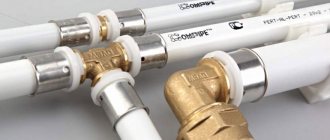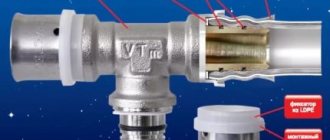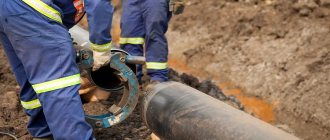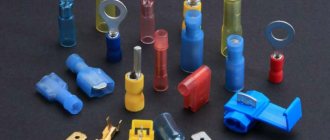List of required tools
It will be simply impossible to carry out all the necessary actions correctly if you do not have a certain set of tools at hand. Not only experienced specialists, but also novice builders know about this mandatory condition of every repair or restoration.
Pipe cutting
If you are going to install pipes made of durable plastic, which will be done with your own hands, and different work methods will be used, then it will not be superfluous to purchase the following items:
- Socket, open-end, and sliding wrenches;
- Pipe cutter;
- Pressing pliers;
- An ordinary pipe bender, as well as an expander.
In order to cut or divide a part into segments or parts, a special device is used - a pipe cutter. It is capable of cutting metal and plastic parts with a diameter of up to forty-two millimeters by manual mechanical action.
Its composition is quite simple. It consists of:
- handles, which are designed for comfortable holding while working,
- sharp blades that are placed inside the tool,
- brackets, which are a fixing element for two handles while they are inoperative.
If this device is not available, then it can be replaced by an ordinary hacksaw, as well as a blade for cutting metal. In principle, you are allowed to independently use any devices that are capable of cutting a metal-plastic product. But it is worth noting that this particular tool can provide smooth and straight cuts at the desired angle.
Sliding key
Socket wrenches, as well as sliding wrenches, are necessary so that you can quickly disassemble or, conversely, assemble the pipeline system. These items are used to tighten nuts and other threaded parts.
An open-end wrench is used quite rarely, only in situations where it is absolutely necessary. But in most cases it is used when it is necessary to screw a part without a thread. Almost always this item is used when it is necessary to connect metal pipes with metal-plastic ones.
Using a gauge, the center distribution of flat cuts is carried out, as well as the removal of a chamfer in the middle of the pipe. It is thanks to this product that complete high-quality sealing at the joints can be guaranteed.
Pressing flares most often clamp removable couplings, with the help of which joint units are connected.
In those parts of the system where you need to make a smooth bend or where it is not possible to cut off a certain piece of the part, you can make a technical bend using a special tool - a pipe bender.
With this item you can make a soft and smooth bend without having to cut the pipe. This is very beneficial; if the part remains intact, it means it will work much longer.
The pipeline mechanism has connections that are permanent. In situations where such connectors need to be expanded, a special expander should be used.
Connecting different pipes
When you have to connect plastic and metal pipes
Metal and plastic are combined in several situations:
- The heating boiler has a metal outlet pipe. If the heating system pipes are plastic, then different materials will need to be joined. Usually a splitter is installed in this place.
- If the house has central water supply and heating, then the likelihood of simultaneous major repairs of external and internal pipes is almost zero.
- If part of the highway being laid is subject to increased mechanical and temperature loads, then this section of the route can be made of metal pipes.
- If technological equipment with plastic leads crashes into the system.
Connection methods
There are some methods and nuances that should be followed during the entire repair process. This is necessary in order to connect everything correctly and prevent even the slightest mistake. The quality and reliability of the entire final result depends on this.
If you make high-quality and tight sealing in those places where the pipes join, then you can be completely confident that the water supply will be stable and no accidents are expected.
In order to start using one or another method of work, it is necessary to carry out preliminary preparatory work, as well as all the important installation and safety rules for it.
Video description
This video shows how to fasten with a Gebo fitting
Pipe welding
Welding is used exclusively for threadless connections of metal pipes. For plastic and metal, this method is only considered if a metal plug or adapter of sufficient length has been previously placed on the end of the plastic pipe to prevent excessive heating of the plastic. Moreover, it is not recommended to use gas welding, as it heats the metal even more.
The standard welding procedure is as follows:
- Bevels are made at the intended location of the seam;
- The joints are cleaned with sandpaper (start with coarse-grained paper and finish with fine-grained sandpaper).
- Welding is performed with a vertical seam. In this case, it is necessary to monitor the arc and the absence of “smudges” from the electrode.
- When the seam hardens, check its strength (by tapping it, for example, with a hammer).
- Next, the seam is cleaned with sandpaper - first coarse-grained and then fine-grained.
The advantages of welding are the simplicity of the process itself, the tightness of the connection, and the ability to use it for any pipe diameter without worrying that the coupling will be small.
On a note! the weld can fail under heavy loads or vibrations because it contains residual stress. Also, classical welding cannot be used to connect iron with copper and aluminum.
Welding seam on metal pipes Source svarkaprosto.ru
Using flanges
Flanges allow you to make a high-quality connection of a profile pipe without welding or threading, which makes them very popular. In addition, all flanges are manufactured in accordance with GOST, which means that finding the right part is quite simple.
Flanges are tension plates that are welded or screwed onto pre-cut threads on pipes. Also included with the flanges are bolts and nuts of suitable diameter, which are used to tighten the plates. The last element of the package is an o-ring, which follows the shape of the flanges and is placed between them during installation.
Example of a flange connection Source trubanet.ru
Connection using push-on fittings
Like all existing types of association, push-on fittings are relatively easy to install. First you need to cut a certain piece of plastic in the area where it is required. After this, a coupling is placed on both ends or on one.
In order for the coupling to fit tightly, it is recommended to process and expand the end of the part using an expander. Next, the coupling is secured by clamping it with press pliers. It is this technology that can provide the required density, without using hot welding or other objects.
Tools required for mounting flanges and connecting them
Installation of flanges for steel pipelines is carried out using the following set of tools:
- Grinder with a circle for stripping and cutting;
- Welding machine of the required power;
- Hammer;
- A set of spanners for tightening pipes. The best option would be a torque wrench or an air impact wrench.
There is no practical use of the flange type of pipeline connection in everyday life; this technology is used in enterprises and factories. In this regard, all structural components undergo strict testing in accordance with all regulations.
Despite the simplicity of installing flange connections on pipeline systems, installation work should only be carried out by specially trained teams of mechanics. And in systems with increased danger (gas pipelines, water pipelines and other pipelines with high pressure), the entire installation or repair process must take place under the supervision of an engineer.
Connecting metal to metal-plastic
As numerous practical cases confirm, sometimes, when it is necessary to replace or restore some plumbing part, it is necessary to combine items that are made from two different materials or substances.
In such cases, it is very important to do everything carefully, step by step in the exact sequence. You can follow various useful recommendations. Most often, for such purposes, a crimp fitting is used, with which pipes can be connected. To do this, you should strictly follow the steps and points provided by the specially compiled instructions:
- First you need to screw the fitting onto a tube made of metal using an open-end wrench. It is recommended to first clean it of dirt, dust and rust. After this, the part is treated with tow and paint in order to protect it from leakage.
- While the paint dries, you can begin working with metal-plastic. It is necessary to carry out calibration, but first put on the press washer.
- The end of the metal-plastic tube must be attached to a cone, which is fixed to a metal object.
- Finally, you need to screw the nut tightly.
Video description
This video shows the installation of a flange adapter (FFRK) - with pressure rings, which allows you to do without welding and threading:
Clip pad
Another fairly simple way to connect two pipes of the same diameter without welding or threading is an outer ring.
The pipes are brought together, a rubber sealing gasket is applied to them, which in turn is clamped with a collapsible clamp - tightened with four or six bolts.
You can also make tees and branches using this method. To do this, one of the parts of the clip must have the appropriate fastening, as in the figure below.
Threadless pipe connection + tee Source lennevaproekt.ru
How to disassemble?
I would like to note in advance the fact that not all types of connections can be disassembled, after which there is no need to replace or repair individual parts, and in some situations, the entire system. By and large, this depends on which particular method of working action was chosen and what additional items were used.
We have already learned how to properly connect using a metal hose and other objects. Now it’s time to figure out how to properly dismantle this entire mechanism.
If removable couplings were installed, but they were compressed, then in order to disassemble all the parts, it is necessary to cut the pipes into pieces. As a result, you will need to purchase new fittings and plastic materials, and this entails extra financial costs that are completely undesirable.
If compression fittings were used, then not everything is so bad. In this case, unscrewing the nuts will be quite simple. After which there will be no difficulties in dismantling the entire sector that must undergo these actions.
Installation of metal-plastic pipes
Before laying plastic pipes, they must be unwound from the coil. If the coils were in the cold, they need to be kept for about a day in a room at a temperature of at least 15 C. When unwinding, you need to make sure that the pipes do not twist.
During installation, tension should not be created. When laying, to prevent dirt and debris from getting inside the pipe , you need to put plugs on its ends. As a rule, plastic products are laid in special shafts, grooves or channels, from where it is necessary to provide access to all detachable connections and fittings; for this purpose, removable doors and shields must be installed.
Due to the elasticity of metal-plastic, installation of heating systems and water supply systems can occur either using a collector or using a classic tee scheme. Laying plastic pipes is as simple as possible, since during installation the number of connections is minimal.
How to connect a plastic pipe to a metal one
The most popular options for connecting metal-plastic pipes to metal ones are:
- using press fittings;
- using compression fittings.
The first of these connection options is divided into two more:
- using a press fitting, which is a slide-on type;
- using a crimp coupling.
Installation tool
Installation of metal-plastic pipes is a very simple procedure that does not require special tools. When connecting with compression fittings for installation, you may need:
- pipe cutter, it can be successfully replaced with a hacksaw;
- a wrench, and ordinary tools that are always in the kit of any master.
When connecting with press fittings, you also need to add press pliers and an expander ; it is used to enlarge the hole in a metal-plastic pipe.
Need for repairs
In some cases, it is necessary, as an emergency, to replace the damaged area with a plastic pipe, and to do this as quickly as possible.
Yes, and when installing a new plumbing system, you often have to connect to an existing utility network consisting of steel or cast iron pipes (read about installing an acrylic bathtub in this article).
Be it connecting to the central water main of a private house or inserting a plastic pipe into the sewer riser of a high-rise building.
The use of threaded connections in such cases is not always justified, and sometimes it is impossible, for example, when connecting a heating expansion tank (how to calculate the capacity is written here) with a cast iron pipe.
How to make a plastic-copper connection?
Options when it is necessary to connect copper pipes to plastic pipes,
happen quite rarely. However, manufacturers have provided for the possibility of such a case, so a fitting consisting of two parts is available for sale: copper and plastic.
The copper part has a smooth end on one side, which is soldered to the main copper pipe. The second end of the copper element is threaded. The plastic part is a nut with a gasket. The nut is screwed onto the thread of the copper element, and the other end of the plastic element is soldered to the plastic part of the communication.
Connection of plastic sewerage with cast iron
This connection option is quite simple, since a wide range of cuffs, corrugations, and seals are available for sale.
Connecting plastic to cast iron
As a last resort, if it is impossible to find the required sealant, then you can use a tape of microporous rubber, cut, for example, from a car mat.
Threaded connection of steel pipes with plastic
To connect pipes with a diameter of less than 40 mm, fittings are most often used, on one side of which there is a thread for a metal pipe, and on the other there is a smooth coupling for a plastic pipe. To reliably seal a threaded connection on a metal pipe, bleached flax fiber is used, which is used when installing conventional metal pipes. The thread can be either internal or external.
The procedure for connecting plastic pipes to steel pipes using threaded fittings:
- From the steel pipe to which it is necessary to connect a new plastic one, unscrew the coupling or cut off part of the old pipe, lubricate the edge of the pipe with grease or oil and cut a new thread.
- The thread is wiped, tow or fum tape is wound, and lubricated with silicone. The sealing material is wound in 1-2 turns so that the edge of the tape, after clamping, is directed along the thread.
- The press fitting is screwed on by hand to avoid cracking. If the connection leaks after turning on the water, the fitting must be tightened.
Polypropylene fittings with threads are designed not only for connecting straight sections, but also for making turns and bends.
Mounting methods
Sewer plastic pipes can be combined with each other in two ways:
Dismountable (coupling and flange).
Non-separable (connection by welding, branching, gluing, using crimps).
With flanges
In this case, the work is performed using a cast iron fastening device and a rubber gasket.
The edges of the pipes are cut off evenly at the connection points, then a free flange is put on, a rubber gasket is inserted, then the edge is attached to it again.
Only after this the entire structure is secured with bolts.
Collapsible
The edges of the pipes are cut off at right angles, then the coupling is put on so that its center and the joining border coincide.
Markings are applied to the products in accordance with the position of the coupling. From the inside, the edges of the elements are coated with lubricant.
Next, one end of the pipe is inserted into the coupling and pulled onto the other, while strictly adhering to the marks.
When installing a non-pressure sewer system, it is allowed to use fasteners made from corrugated pipes.
Both of these methods are not expensive and do not require special tools or expensive equipment.
With welded seam
In order to connect the elements end-to-end, you will need professional tools - plastic welding equipment.
First, the ends of the pipes need to be heated until they begin to melt.
Then we press the softened ends against each other and wait some time until the plastic cools completely.
At the joints, a monolithic joint is obtained, the strength of which is identical to the quality of a regular section of pipe.
When arranging a small sewer system, you do not need to specifically buy a welding machine; it will not justify itself. In this case, the connection of plastic pipes can be done using fittings.
Attention! Not every home craftsman can do this work. Not everyone knows how to operate welding machines.
The adhesive version involves the use of a special glue that is designed for these purposes.
Before starting work, you need to carefully study the recommendations of the adhesive manufacturer. Step-by-step instruction:
- we clean and degrease the surfaces that will come into contact with each other when gluing;
- Apply adhesive to the edges to be glued with a small brush;
- We insert the PVC products into one another, fix them in a stationary position and hold them there for several minutes.
During this time the glue will set well.
To secure the result, the joints need to be sealed again with an additional layer of adhesive.
Thus, the structure will become more durable and invulnerable to leaks at the interface points.
Connecting pipes “into a socket”
Experts consider the socket connection to be the simplest and most reliable.
The use of shaped products makes this installation method affordable in monetary terms for families with average incomes.
Good sealing of this method is achieved by compressing the rubber rim on the socket and the ground end of the pipe.
The edges of the product are coated with silicone and inserted into the pipe, and the pipe itself is fixed to the load-bearing surface.
Do not forget that the socket must be facing in the opposite direction from the flow of sewage water.
Instead of silicone grease, you can use liquid soap or any detergent that you currently have in your household.
You can cut plastic products with a regular hacksaw with fine teeth.
Tying polypropylene pipes instructions
Radiator piping can be done using a variety of pipes, but experts recommend using polypropylene pipes. Ball valves for piping are also purchased in polypropylene; they can be straight or angular; this option is the simplest and most inexpensive. Brass fittings are more expensive, and their installation is more difficult.
Polypropylene strapping is done as follows:
- the coupling with a union nut is inserted into the multiflex, which easily connects to any outlet;
- The pipes themselves are attached to the walls at a convenient height; they should not fit tightly to the surface; it is better to leave a gap of 2-3 cm. The pipes are secured using special brackets, which are fixed to the wall with nails or self-tapping screws.
Polypropylene piping to radiators can also be carried out when laying pipes in the wall, in which case they come to the surface only at the connection points.
Radiator piping can be done using a variety of pipes, but experts recommend using polypropylene pipes.
Battery fasteners can be very different, most often it is a pin connection that is fixed to the wall surface. Corner brackets can also be used, which also allow radiators to be suspended at the required height. For panel batteries, fasteners are supplied included; for sectional batteries, they must be purchased separately. Typically, two brackets or pins are sufficient for one section.
The taps are connected as follows:
- the tap is disassembled, the fitting and union nut are screwed into the radiator;
- Use a special wrench to tighten the nut tightly.
As you can see, this process is extremely simple. To perform such work, you only need to purchase a special plumbing wrench for American women, without which it is unlikely that you will be able to simply install a faucet.
To install batteries and tie them, the following materials and tools are required:
- a set of special keys;
- seals for threaded connections;
- tow and thread paste;
- threads for carving.
Features of connecting radiators
Heating installation has some features:
- It is necessary to maintain a distance of 100 mm from the radiator to the window sill. If the gap between the batteries and the bottom of the window sill is different, then the heat flow is disrupted and the effect of the heating system will be low.
- The distance from the floor surface to the battery should be 120-150 mm, otherwise a sharp temperature change will occur.
- In order for the heat transfer of the equipment to be correct, the distance from the wall must be at least 20 mm.
At the same time, we take into account that the installation and efficiency of heating radiators is greatly influenced by the installation method: under an open window sill the efficiency of the heating system is maximum - 96-97%, in an open niche - up to 93%, in a partially closed form - 88-93 %, completely closed - 75-80%.
The heating radiator can be installed using a variety of methods; its piping is done with metal, polyethylene, polypropylene pipes
During installation, it is important to correctly position not only the pipes, but also the batteries themselves, and make the connection in accordance with all recommendations and standards. In this case, the heating system will work very efficiently and will not require repair work. Share a useful article:
Share a useful article:
Bending technologies
Before bending metal-plastic pipes, you need to decide which bending method to use. Each approach has features, advantages and disadvantages. We list the methods for bending metal-plastic products:
- DIY bending. A simple, low-cost method. The disadvantage is the high probability of deforming the part.
- Using a pipe bender. The tool allows you to bend the pipe at the required angle, eliminating the occurrence of defects. The high cost of a pipe bender does not justify its single use. It is recommended to purchase for ongoing large-scale work.
- Use of sand. A dusty, energy-consuming method that allows you to achieve accurate results.
- Application of a spring. An accurate method that eliminates the appearance of defects when bending. The disadvantage is the difficulty in choosing the required diameter of the device.
Let us consider the bending technology of each method in detail.
Manual method
When bending manually, the main rule is not to make sudden and fast movements. The product is clamped in one hand, and with the other, a careful deflection is performed to the previously calculated radius. It is recommended to make the first bend at 20°, no more. Then step back 10 mm from the bend and bend again with a small amplitude. 10-15 such non-amplitude bends should be performed so that the metal-plastic part rotates 180°. If the need arises to straighten the pipe, do the same, only in reverse order.
Using sand
This method is most often used if it is not possible to find the right size spring. Sifted sand is poured into the pipe so that there are no voids left. The ends of the pipe are closed with plugs to prevent sand from spilling out. The part is clamped with cleats in a place that is remote from the bending point.
Before bending, the required area is heated with a blowtorch. You need to heat it carefully, checking the degree of heat of the sand with paper (smoldering paper is a sign that the sand is heated to the desired temperature). After heating, we give the product the desired shape and pour out the sand.
Application of pipe bender
A pipe bender is a tool that can be used to bend a metal-plastic product at home. The device consists of a movable roller and a template roller, a bracket, a handle and a curved pipe. The machine bends products without preheating, the maximum bend is 180°, the process is safe, the appearance of defects is excluded.
The Volnova machine is designed simply; you don’t need any special skills to use it. At home, crossbow or spring pipe benders are more often used. The surface that bends the tube must be oiled before using the machine. This will reduce friction and the risk of damage.
More advanced models of pipe benders are also available in specialized stores. But purchasing hydraulic or electromechanical machines is only advisable if a large volume of work is performed.
Spring application
Using a spring to bend metal-plastic pipes is a proven method. For this process you will need a spring of suitable diameter. To give the product the desired shape, you need to follow simple instructions:
- Place the fixture in the pipeline part. The spring should be located directly at the bend.
- Gently, without sudden movements, bend the part at the desired angle.
- Remove the spring.
Each of the presented methods is reliable and effective. By acting slowly and carefully, it is possible to bend a metal-plastic pipe of different diameters at the required angle. It is not necessary to buy expensive devices.
Flange application and installation method
Installation of flange connections is carried out on pipelines whose diameter starts from 32 mm. Installation of steel pipelines used for wastewater or pumping air masses is carried out on oval flanges. On other, more critical systems, only round flange connections are used.
According to the installation method, all types of pipelines are divided into free and rigid. The first ones are mounted on threaded connections, and to increase their reliability, they are sealed with special materials (fum tape, tow, Loctite, etc.), and the edges are flared. Rigid connections are secured by welding.
Methods
There are several ways to connect polypropylene communications. Choosing which method to use depends on the type of PP pipes and their purpose.
Cold welding is based on gluing elements together with a special adhesive composition. It is applied to the parts that need to be connected. First, the surfaces to be bonded must be degreased. After applying the glue, wait a while and connect the pipe to the desired element. After a short period of time (approximately 20 minutes), the connection will stabilize and be reliable.
Connection using steel or cast iron fittings. This method is suitable for pipelines with a small diameter. Typically, fittings are installed on bends and branches of communications. The fitting includes elements such as a cover, a sleeve and a clamping ring, which is located in the socket of the product. The pipe is fixed using the seam ring included in the fitting design.
When connecting with fittings, you must follow a step-by-step action plan:
- the pipe cut must be made at a right angle;
- it is necessary to remove all burrs on the surface to be joined;
- then you need to install the nut from the fitting onto the pipe and put the clamping ring on it;
- After this, you need to insert the pipe into the fitting and secure the connection with a clamping ring and nut.
Connections using flanges are considered very reliable and can withstand high temperatures and high pressures. This method is used when it is necessary to connect polypropylene pipes without resorting to welding. For connection, bolts are used that are screwed into the flange thread.
When connecting with flanges, the following installation rules must be observed:
- at the pipe connection it is necessary to make a cut, avoiding the appearance of burrs;
- the gasket that is installed on the cut must have a protrusion of 15 cm;
- a gasket is placed on the flange and connected to another flange installed on another pipe to be connected;
- The gaskets must be installed in such a way that their cross-section does not touch the bolts;
- More than one gasket cannot be installed on a flange, as this will reduce the tightness.
Connection using couplings. To connect with couplings, you need to make a thread on the pipes for their subsequent installation and, to make the connection tight, wrap a little tow around it. The edges to be joined should be cut evenly and the location of the coupling should be marked with a marker. Then you need to apply lubricant to the coupling and install it on the pipe in the previously marked place.
Welding refers to the hot joining method. This type of connection is one of the most reliable, and its essence lies in the melting of polypropylene with a special apparatus under the influence of a temperature of 260 C. The elements heated to the required temperature are pressed tightly against each other, and after they cool, a reliable connection is formed. The time after joining until the final polymerization of polypropylene will take 20 minutes.
When connecting by welding, the following sequence of actions should be observed:
- turn on the welding machine and heat it to a temperature of 260 C;
- you need to put the device nozzles on the propylene pipes to be connected - this needs to be done very quickly;
- when the elements to be welded begin to melt, they are removed from the apparatus;
- connect the molten elements to each other by pressing firmly for 15 seconds;
- The connected elements must be allowed to polymerize to fully set - this usually takes about 20 seconds.
Common mistakes when connecting by welding:
- displacement of elements during welding at the moment of their heating;
- when joining elements, they must not be rotated - otherwise the seam will be unreliable;
- When welding the valves, the location of the valves was not taken into account, and they cannot move freely.
Sewer pipes
With modern plastic pipes, you have to connect plumbing accessories and appliances (how a bidet works) to an existing sewer system made of cast iron.
Along the way, we need to solve the problem of mismatched diameters.
The most common sizes of plastic pipes are 110 and 50 mm, and cast iron pipes are 123 and 73 mm, respectively.
First, you need to dismantle the old connection and remove the section of pipe to be replaced from the pipe. It is at this stage of work that the main difficulties arise and mistakes are made.
The main rule is that brute physical force should never be used.
And second, do not try to split a cast iron pipe by hitting it with a hammer.
This can lead to not only the desired section cracking, but also the rest of the pipe.
Metal-plastic pipes - pros and cons
They are also popular due to some advantages. Details:
- Metal-plastic pipes bend. They can be easily installed without transitions, to any length.
- There are several methods for joining - crimp or compression fittings, threads. No special skills are required to operate.
- The advantage of a metal-plastic pipe is its neat, thin appearance. With them, home plumbing is neat and unnoticeable. If desired, it can also be hidden in grooves, making installation simpler and easier.
Minuses
Now about the unpleasant - the disadvantages are numerous:
- The diameter of metal-plastic is comparatively smaller than polypropylene - up to 63 mm, which indicates the impossibility of installing large networks.
- Metal-plastic is not able to withstand high carrier temperatures - up to 75 C, which, however, is sufficient for apartment heating. For a private home where there is proximity to a heat source, this is unacceptable.
- The pressure that metal-plastic pipes can withstand is small - 10 atm. With an increase, depressurization and damage to the wiring is possible.
- The main disadvantage is the threaded connections. Made by a master, they still flow over time. In addition, a sealant is required - fum, tangit-unilok, etc.
- And finally, metal-plastic is not considered environmentally friendly. The foil and reinforcement inside can become rusty. Accordingly, water quality will deteriorate.
So, the conclusion is clear - for private or residential water supply it is better to use polypropylene. Reliable pipes, coupled with the work of a master, will serve the owners for a sufficient period of time.
Types of connections. Their advantages and disadvantages
The main methods of connecting plastic sewer or water pipes are:
- welding;
- compression fittings.
Welding creates a strong connection. To carry out welding work, a special apparatus is required. A significant disadvantage of welding is that it produces a permanent connection, that is, if a leak is detected in the joint, a complete replacement of the unit will be required.
Connecting plastic pipes by welding
Welding can be used to connect polypropylene, polyethylene and polyvinyl chloride pipes.
The use of compression fittings is permissible when constructing a pipeline from the following types of plastic pipes:
- metal-plastic;
- polypropylene;
- polyethylene.
The connection using a fitting is detachable, which allows for periodic repair work without replacing individual elements of the pipeline system. At the same time, it turns out to be highly durable and not subject to mechanical stress.
Special fittings for connecting plastic pipes
In addition to the main ways to connect pipes, you can:
using a special glue that softens the top layer of plastic for a while to obtain a connection. This procedure is also called cold welding. PVC pipes are mainly installed using the cold welding method in the construction of domestic pipelines;
Application of cold welding
electric couplings (used for polyethylene pipes). The connection is made by melting the spirals located in the fitting. The use of electric couplings is permissible in the construction of both external and internal pipelines. However, expensive equipment is required to get the job done;
Connecting pipes with electric couplings
compression fittings. A distinctive feature of this type of fitting is the presence of a special ferrule, which is used to create a connection between the pipe and the fitting;
Using a Compression Fitting to Connect Pipe
push fittings. New fittings allow you to quickly and reliably assemble pipelines without additional equipment.
Technology for installing new push fittings
Push fittings and crimp fittings can only be used when constructing a pipeline from metal-plastic pipes. For other types of pipes this connection is not acceptable.
